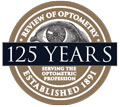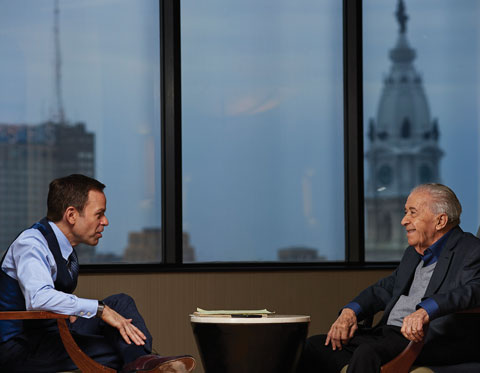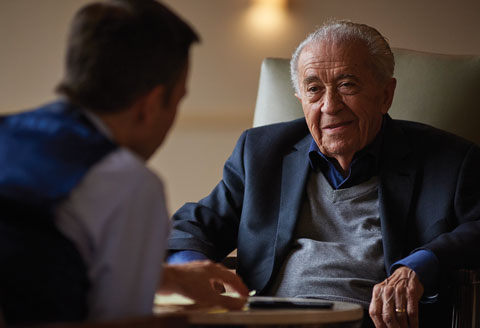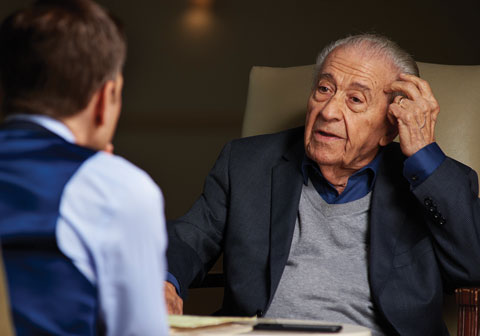 |
Few optometrists today are as well known, or as beloved, as “Uncle” Frank Fontana, OD. His influence cuts across generations, with both his contemporaries and younger optometrists expressing admiration and respect for him as a doctor, an educator and a person.
Dr. Fontana, a native of St. Louis, began practicing optometry in 1950 and still sees patients three mornings a week, giving him an astounding and likely record-breaking 66 years in clinical practice. To honor optometry’s favorite uncle, I sat down with him to talk about his life story and his many contributions to the profession he dearly loves.
One month shy of his 94th birthday, Uncle Frank is as sharp and funny as ever.
Can you tell me about your life before optometry?
My dad came from Sicily and settled in St. Louis. He had been in World War I and was a very patriotic guy. He taught my brother and I, right from the beginning, to appreciate living in the United States and our lives here because it’s full of opportunities. He was a very hard working guy. He wanted his boys to go to college, so he made sure my brother Eddie and I had that chance. Then both of us got caught by World War II—but we wanted to go and serve. I had finished one year of college before going into the service. I went into the Army January 4, 1943 and was in the service 35 months. Twenty-eight of those months were in Europe.
Basic training mainly consisted of walking like crazy, building your endurance up. But the interesting part about that was that, after you finished training, a new unit would be created—we were just building up our military at that time. This new organization started and it was called the 93rd Medical Gas Treatment Battalion. And by “gas,” they meant poison gas. They needed 500 guys, so they just picked the first 500 names. It didn’t matter what expertise you had, if you had any. So that’s how I ended up in the medical corps! It had none of my aspirations at the time.
Our outfit was the first of its kind. We were in a portable hospital unit, treating poison gas by washing it off soldiers who had been exposed. We would take care of a whole division of infantry, which is 16,000 to 17,000 men, so we had to travel fast.
Later in the war, I was promoted from private first class to staff sergeant and reassigned to England. I spent July to November 1943 in Oxford, and we went to London often. The Battle of Britain was already over by then, but there were still no lights allowed in case of attack. Imagine Piccadilly Circus totally black! What a sight. I still remember walking around London in the dark, lit only by fluorescent strips that pointed down at street level but couldn’t be seen from above.
 |
Not quite a year later, while I was stationed in Southampton, I went for a walk one morning and I heard this incredible roar in the air. I looked up and an armada of planes went right over us. That day was June 6, 1944, otherwise known as D-Day. Southampton is just across the English Channel from France and those were our planes going in for the attack.
How did you get into optometry?
In the Army, I was exposed to a lot of medical people. So I decided I wanted to do something medical after the war. At the time, medical school was eight years, dentistry was six years and optometry was four.
Back in St. Louis, my dad worked in a department store as an ice cream maker, and his best friend was the store’s optometrist. So, my dad brought me in to meet him. “It’s a clean profession,” the optometrist told me. “You make people see. You would like it if you went into it.” So that’s what I did. I was 23 at the time.
I enrolled in what was then called Northern Illinois College of Optometry, in Chicago. It was a four-year course, which was rare at that time. A lot were still just two years. And being a veteran, the G.I. Bill paid for all of it—books, tuition, everything. That was such a wonderful program that really did so much for our country.
What was optometry like when you entered practice?
Busy! A huge number of optometrists had descended on every state, because the schools were putting out so many at that time.
I don’t think optometry would have improved as much and made the strides it did without the G.I. Bill. It added so many talented people to our ranks at just the right time for what the profession was taking on then. Optometry as it’s practiced today—treating pathology and such—really started with our generation. We were the first ones that got an education on anatomy and pathology in school, along with the usual vision and optics.
Contact lenses as we know them now didn’t really exist yet. In school, we had read things about them. But as far as fitting them, we had no idea. All we had was scleral lenses. I remember we each molded someone’s eye and then they molded you. Boy, I never said so many Hail Marys in my life as when they stuck that lens in.
It’s funny, life is a matter of luck a lot of the time. Two years after I graduated, I was having trouble financially—there wasn’t really anything there for me just yet. My mother was going to an ophthalmologist for care and she got me in to meet him. So I offered to do all his refractions for him, and he could do the medical part. He agreed and that’s what I did. So, that’s how I got interested in pathology, because I saw it all the time.
But you also had your own optometry practice too, right?
Yes, I would be at the ophthalmology office in the mornings and in the afternoons I was building my own practice. But I have to say, optometry was boring at that time. It wasn’t exciting at all. We just didn’t have much to do. Contacts didn’t exist yet. And I wasn’t busy then.
 |
How many patients would you see in a day?
Maybe four! [laughs] Six on a busy day. It just took time to build up a patient base. People didn’t know what an optometrist was. They knew that it had to do with optical devices in some way, but they still associated us with jewelry stores. They didn’t know our capabilities.
When did things start to pick up?
In 1957, when we discovered contact lenses, thanks mostly to Drs. Wesley and Jessen from Chicago. They were fascinated by this stuff, and they taught us all to fit them. By the way, the early contact lenses were all PMMA materials and the diameter was 9.2mm with a 4/10th bevel and an optic zone of about 7.8mm. We went through all kinds of diameters—up to 11.2, down to 8.7 and so on—and we ended up right back at 9.2. That’s still the average diameter today.
Then in 1961, a young ophthalmologist in town was looking to get in touch with an optometrist. He asked four different optical stores who they recommended, and they all said me. So I worked with him, and that’s what really built my practice. His dad had started the ophthalmology center at Washington University, and I became their contact lens guy.
What sort of equipment did you use then?
Not much. A phoropter, retinoscope, ophthalmoscope and a very crude keratometer that wasn’t any good. We had a slit lamp too, but it was terrible. It was so rudimentary and so new that about all we could do was turn it on.
What would you do if a patient came in with a problem that was more medical, like an infection or a foreign body?
One of the lucky things in my career is working with ophthalmology. They gave me their consent to use an anesthetic if I wanted, to tide the patient over until I got them to the ophthalmologist. At that time, we weren’t licensed to do this, so [pause] well, the state board can go after me now if they want, I don’t care. [laughs]
But I learned so much from being with those ophthalmologists. It was like going to school every day. We did so many aphakics, since it was a surgical practice. We would fit them in contact lenses. That’s really how I got into learning the value of contact lenses for people, since they made such a difference for aphakic patients. This was the time before intraocular lenses. The post-cataract glasses were so thick and hard for patients to wear.
So, you got interested in contact lenses because they could help post-cataract aphakic patients?
No, I got into contact lenses because I was bored with optometry. I hate to tell you this—I’m being very candid—but it was so boring. We didn’t have the right instruments and we couldn’t do any more than refraction. So when contact lenses came along, I jumped at the opportunity. It was so different and so interesting.
And being with the ophthalmologists was a real blessing then because they didn’t want to fit them. They didn’t even believe in them.
Do you remember fitting your first patient?
Yes, I do. I was scared to death. And so was she.
When a patient would come in for follow up, we didn’t have much we could to do other than use fluorescein and a crude black light, so we did keratometry. And we started noticing something: it was changing. We didn’t know what that meant. We had a lot of patients who developed astigmatism from those early lenses. It was a learning game for all of us. We had study groups and so on, to share our experiences and ideas.
 |
Who were some of the people who influenced you then?
Oh, so many great people made a difference to my generation of optometrists. Linda Casser, OD, was a wonderful teacher. She taught us about pathology and made us feel comfortable with it.
Lou Catania, OD, was the one of the first optometrists who really got us into treating eyes. He would always lecture on it, and a lot of the message was about having courage.
In the same way, Jimmy Bartlett, OD, and of course Randall Thomas, OD, and Ron Melton, OD, all gave us not just education on how the drugs worked, but also helped us gain the confidence to use them. It’s one thing to know how drugs work, but when these guys shared their experiences, we could imagine ourselves doing it too.
Brien Holden was both a brilliant man and a wonderful person to be around. He was a force to be reckoned with and a good friend of mine. He’s the one that made us for real. Not only did he give us courage, he was a role model. He was an optometrist, a teacher, a PhD and a researcher. He made optometry a real profession and got us more respectability than anyone. He was like a marble bust on a mantel to us.
Irv Bennett, OD, was a big influence too. Irv is a very smart man. He taught us how to be businesspeople. In fact, he got my career as a speaker started. He would invite me to talk at his OptiFair meetings and he literally made my career because of it. He would list the speakers in the ads for the meeting and that got our names out there.
You did become a fixture on the lecture circuit, and even helped to found the Heart of America conference, is that right?
Yes, I was close with Jack Hartman—who was first an OD and then an ophthalmologist—and the others who got it started. There wasn’t really very much good education yet, so they decided to get all of us together to share our knowledge. We only had something like 30 attendees at the first meeting in 1962. And probably 20 of them were from industry. Nowadays, the meeting draws 800 doctors every year.
And then a few years later you started the AOA Contact Lens Section, too. How did that happen?
That was a hard one to do. I was the AOA’s contact lens committee chairman, and my allowance was $200 a year. That didn’t amount to much to devote to contact lens education, so I talked with them about an idea for a new section. We had a regular speaking group that went to all the meetings and we would always ask people if they would be willing to sign up to join a new section, so I knew we would have people interested in it. I asked the AOA to put the idea before the board—and they voted it down. It would be too costly to run. But I told them we wouldn’t need it—I already had a list of 300 people who had already made a pledge to contribute. So I wrote to everyone, and every single one of them sent a check.
What do you think of the current make-up of optometry, with medical topics so much a part of it?
My generation really distinguished itself by taking on disease treatment in addition to all our traditional duties. And we made contact lenses a success. But I think we’re going too far by getting interested in surgery. It’s not the same profession. I think what we optometrists do—like the department store clerk told me all those years ago—is that we make people see. That’s still our core strength. Surgery feels to me to be too far from who we are.
I am impressed with the young optometrists because they’re so smart. They have better training than any of us who came before could have dreamed of. They have great opportunities ahead of them.
Any final thoughts on what helped you to succeed that would be a good lesson for younger doctors?
The biggest thing is to not put yourself above the patient. I’ve always treated my patients like friends, never with haughtiness like some doctors feel entitled to do. You can be very friendly and close to your patients without being too personal. Early in the game, we sometimes used to get too personal. Back in the ’50s, I used to have people call me to ask me to solve their kids’ geometry problems over the phone. [laughs]
My advice is to be nice and be professional without displaying haughtiness—patients will learn to love you. They’ll keep coming back and won’t go anywhere else. Even today I have patients say to me at the end of an exam, “I’m going to come back in a year. Are you going to be here?” I say “yes,” and they’re pretty excited about that.
